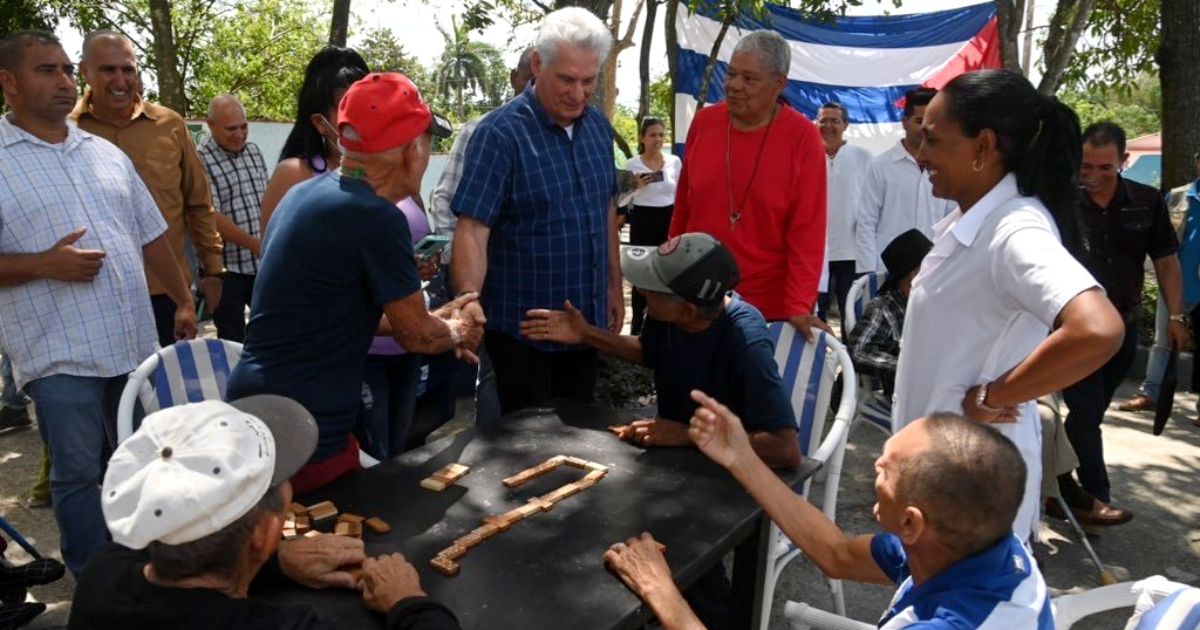On Friday, Cuban leader Miguel Díaz-Canel visited the "Rogelio Rojas Tamayo" elderly home in the Colombia municipality of Las Tunas province. The visit, heavily promoted by state-run media, was presented as evidence of alleged improvements in senior care on the island.
During his visit, Díaz-Canel listened to testimonies from seniors who claimed to receive "pretty good food" and "wonderful attention," according to a report by Visión Tunera. These statements seem to gloss over the harsh realities faced by this demographic across Cuba. "Here we receive good service... uh... [I’m] proud to be here. The food is pretty good, the attention is wonderful," an elderly resident told the official media. Díaz-Canel expressed his "satisfaction at seeing them well cared for, something you deserve at this stage of life because you have done so much for the country and the Revolution."
The report stated that the facility underwent renovations with a two-million Cuban peso investment, which was used to refurbish floors, walls, carpentry, and painting. However, beyond this public display, the living conditions for the elderly in Cuba remain far from adequate.
Recent reports by CiberCuba highlight how thousands of retirees and senior citizens survive under extreme conditions, with meager pensions, lack of access to medicines and food, and many resorting to scavenging to make ends meet. While the regime allocates fourteen times more funding to the tourism sector than to Public Health and Social Assistance, Cuban seniors grapple with food shortages, deteriorating social care facilities, and the absence of an effective support network.
Incidents like that of an elderly Havana woman seeking food aid from an activist, or retirees begging to survive, underscore the neglect and hopelessness that define old age in Cuba. Currently, seniors are the only growing demographic group on the island, exacerbating the demographic crisis and placing more pressure on a social system incapable of meeting their basic needs.
Rather than showcasing progress, the government's propagandistic visits aim to mask a structural crisis that particularly affects the most vulnerable sectors. The short performance in Las Tunas contrasts starkly with everyday realities: long lines for subsidized food, dilapidated housing, resource-strapped hospitals, and a declining quality of life.
Díaz-Canel's words to the seniors in Las Tunas, spoken in a controlled environment, bear little resemblance to the daily hardships faced by thousands of Cuban elders, who, after decades of work, find themselves in the twilight of their lives amid neglect and poverty. The visit of the leader appointed by Raúl Castro, one of the few privileged nonagenarians in the regime, fails to conceal the profound crisis affecting the elderly in Cuba or mitigate the mounting social discontent over the lack of effective public policies to protect those most in need.
Understanding the Plight of Cuban Seniors
What are the living conditions like for seniors in Cuba?
Many Cuban seniors live in extreme conditions with insufficient pensions, limited access to food and medicine, and often have to resort to scavenging to survive.
How does the Cuban government prioritize senior care?
The Cuban government invests significantly more in tourism than in Public Health and Social Assistance, leaving the social care system for seniors underfunded and inadequate.
What was the purpose of Díaz-Canel's visit to the elderly home?
Díaz-Canel's visit was promoted by state media as a demonstration of improvements in senior care, although it appears to have been more of a public relations effort than a genuine assessment of conditions.
